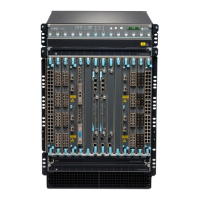opcal modules or cables. Your JTAC engineer will likely request that you check the
third-party opcal module or cable and, if required, replace it with an equivalent
Juniper-qualied component.
Use of third-party opcal modules with high-power consumpon (for example,
coherent ZR or ZR+) can potenally cause thermal damage to or reduce the lifespan of
the host equipment. Any damage to the host equipment due to the use of third-party
opcal modules or cables is the users’ responsibility. Juniper Networks will accept no
liability for any damage caused due to such use.
The Gigabit Ethernet SFP, SFP+, and QSFP+ transceivers and the 100GBASE-LR4 CFP transceivers
installed in EX9200 switches support digital opcal monitoring (DOM): You can view the diagnosc
details for these transceivers by issuing the operaonal mode CLI command show interfaces diagnostics
optics.
Overview of EX Series Switches: Fiber-Opc Cable Signal Loss,
Aenuaon, and Dispersion
IN THIS SECTION
Signal Loss in Mulmode and Single-Mode Fiber-Opc Cable | 138
Aenuaon and Dispersion in Fiber-Opc Cable | 139
To determine the power budget and power margin needed for ber-opc connecons, you need to
understand how signal loss, aenuaon, and dispersion aect transmission. EX Series switches use
various types of network cables, including mulmode and single-mode ber-opc cable.
Signal Loss in Mulmode and Single-Mode Fiber-Opc Cable
Mulmode ber is large enough in diameter to allow rays of light to reect internally (bounce o the
walls of the ber). Interfaces with mulmode opcs typically use LEDs as light sources. However, LEDs
are not coherent light sources. They spray varying wavelengths of light into the mulmode ber, which
reects the light at dierent angles. Light rays travel in jagged lines through a mulmode ber, causing
signal dispersion. When light traveling in the ber core radiates into the ber), higher-order mode loss
(HOL) occurs. (Cladding consists of layers of lower-refracve index material in close contact with a core
138

